Optimal Scheduling of a Multi-Energy Hub with Integrated Demand Response Programs
Abstract
1. Introduction
Related Literature Reviews
- Many models are confined to single-carrier systems or limited EH structures, without fully capturing the synergies between electricity, gas, heat, renewables, storage, and DR.
- The majority of existing DR studies emphasise cost minimisation, but neglect cross-carrier substitution effects that arise in integrated hubs.
- Few works critically examine practical constraints such as storage charging/discharging logic, efficiency losses across converters, and operational feasibility under varying market conditions.
- Development of an MILP-based optimisation framework for a decentralised multi-energy hub that simultaneously integrates multiple carriers (electricity, heat, natural gas), wind generation, storage, and DR.
- Critical analysis of the interactions between storage systems, renewable resources, and DR under different market and technical conditions, highlighting their combined impact on operational cost and demand profile.
- Introduction of case studies that demonstrate how DR participation under both high and low gas prices can reshape hub operations, reduce peak demand, and improve renewable utilisation.
- Identification of research and practical implications for the real-world deployment of multi-energy hubs, including operational security and informatics challenges.
- Investigation of the effects of low-cost gas for both DRS and non-DRS scenarios.
- Assessment of DRS in the absence of CHP.
2. Proposed Smart Energy Hub Model Description
3. Problem Formulation
3.1. Objective Function
3.2. Constraints of Wind Power
3.3. Operation Constraints
3.3.1. Demand Constraints
3.3.2. The Smart Energy Hub Electricity Demand Constraint
3.3.3. The Smart Energy Hub Heat Demand Constraint
3.3.4. The Smart Energy Hub Gas Demand Constraint
3.4. Network Constraints
3.4.1. Converters Constraints
3.4.2. The Smart Energy Hub Components Constraints
3.5. Energy Storages Constraints
3.5.1. Electrical Battery Storage Constraints
3.5.2. Thermal Storage Constraints
3.6. Demand Response Constraints
4. Case Studies and Simulation Results Analysis
4.1. An Energy Hub Case Study with Five Different Operational Scenarios
- Scenario Number 1: Optimisation of the smart energy hub while taking the high cost of natural gas into consideration, but without addressing DR.
- Scenario Number 2: Optimising the smart energy hub while considering the concurrent DR program and high natural gas prices.
- Scenario Number 3: Optimising the smart energy hub while ignoring DR and taking into consideration the cheap price of natural gas.
- Scenario Number 4: Optimisation of the smart energy hub considering the simultaneous low natural gas price and DR program.
- Scenario Number 5: Optimisation of the smart energy hub without considering the implementation of CHP.
4.2. Simulation and Results Analysis
- Scenario 1:
- Scenario 2:
- Scenario 3:
- Scenario 4:
- Scenario 5:
5. Conclusions
Author Contributions
Funding
Data Availability Statement
Conflicts of Interest
References
- Onen, P.S.; Mokryani, G.; Zubo, R.H. Planning of multi-vector energy systems with high penetration of renewable energy source: A comprehensive review. Energies 2022, 15, 5717. [Google Scholar] [CrossRef]
- Wu, Q.; Zheng, J.; Jing, Z.; Zhou, X. Large-scale integrated energy systems. In Energy Systems in Electrical Engineering; Springer: Singapore, 2019. [Google Scholar] [CrossRef]
- Amin, A.; Kem, O.; Gallegos, P.; Chervet, P.; Ksontini, F.; Mourshed, M. Demand response in buildings: Unlocking energy flexibility through district-level electro-thermal simulation. Appl. Energy 2022, 305, 117836. [Google Scholar] [CrossRef]
- Onen, P.S.; Mokryani, G.; Zubo, R.H. Optimal Operation of Energy Hub with high penetration of renewable energy sources. In Proceedings of the 2nd International Multi-Disciplinary Conference Theme: Integrated Sciences and Technologies, IMDC-IST 2021, Sakarya, Turkey, 7–9 September 2021; European Alliance for Innovation: Vazovova, Slovakia, 2022; p. 26. [Google Scholar]
- Dumas, J.; Dubois, A.; Thiran, P.; Jacques, P.; Contino, F.; Cornélusse, B.; Limpens, G. The energy return on investment of whole-energy systems: Application to Belgium. Biophys. Econ. Sustain. 2022, 7, 12. [Google Scholar] [CrossRef] [PubMed]
- Maghsoodi, S.; Talavat, V.; Galvani, S. Probabilistic scheduling of a comprehensive energy hub integrated with renewable energy sources considering the correlation between uncertain variables. Sustain. Energy Grids Netw. 2023, 36, 101222. [Google Scholar] [CrossRef]
- Liu, T.; Zhang, D.; Dai, H.; Wu, T. Intelligent modeling and optimization for smart energy hub. IEEE Trans. Ind. Electron. 2019, 66, 9898–9908. [Google Scholar] [CrossRef]
- Miao, C.; Wang, Q.; Tang, Y. A multi-energy inertia-based power support strategy with gas network constraints. Prot. Control Mod. Power Syst. 2023, 8, 18. [Google Scholar] [CrossRef]
- Germscheid, S.H.; Mitsos, A.; Dahmen, M. Demand response potential of industrial processes considering uncertain short-term electricity prices. AIChE J. 2022, 68, e17828. [Google Scholar] [CrossRef]
- Song, X.; Wang, Y.; Zhang, Z.; Shen, C.; Peña-Mora, F. Economic-environmental equilibrium-based bi-level dispatch strategy towards integrated electricity and natural gas systems. Appl. Energy 2021, 281, 116142. [Google Scholar] [CrossRef]
- Zhang, S.; Zhang, X.; Zhang, R.; Gu, W.; Cao, G. N-1 evaluation of integrated electricity and gas system considering cyber-physical interdependence. IEEE Trans. Smart Grid 2025, 16, 3728–3742. [Google Scholar] [CrossRef]
- O’Malley, M.; Kroposki, B.; Hannegan, B.; Madsen, H.; Andersson, M.; D’haeseleer, W.; McGranaghan, M.F.; Dent, C.; Strbac, G.; Baskaran, S.; et al. Energy Systems Integration: Defining and Describing the Value Proposition; National Renewable Energy Lab. (NREL): Golden, CO, USA, 2016. [Google Scholar]
- Yang, M.; Li, X.; Fan, F.; Wang, B.; Su, X.; Ma, C. Two-stage day-ahead multi-step prediction of wind power considering time-series information interaction. Energy 2024, 312, 133580. [Google Scholar] [CrossRef]
- Onen, P.S.; Zubo, R.H.; Ali, N.T.; Mokryani, G.; Li, J.-P.; Abd-Alhameed, R. Stochastic Expansion planning Model for a coordinated Natural gas and Electricity Networks Coupled with Gas-fired Generators, Power-to-Gas Facilities and Renewable Power. IEEE Access 2024, 12, 105811–105830. [Google Scholar] [CrossRef]
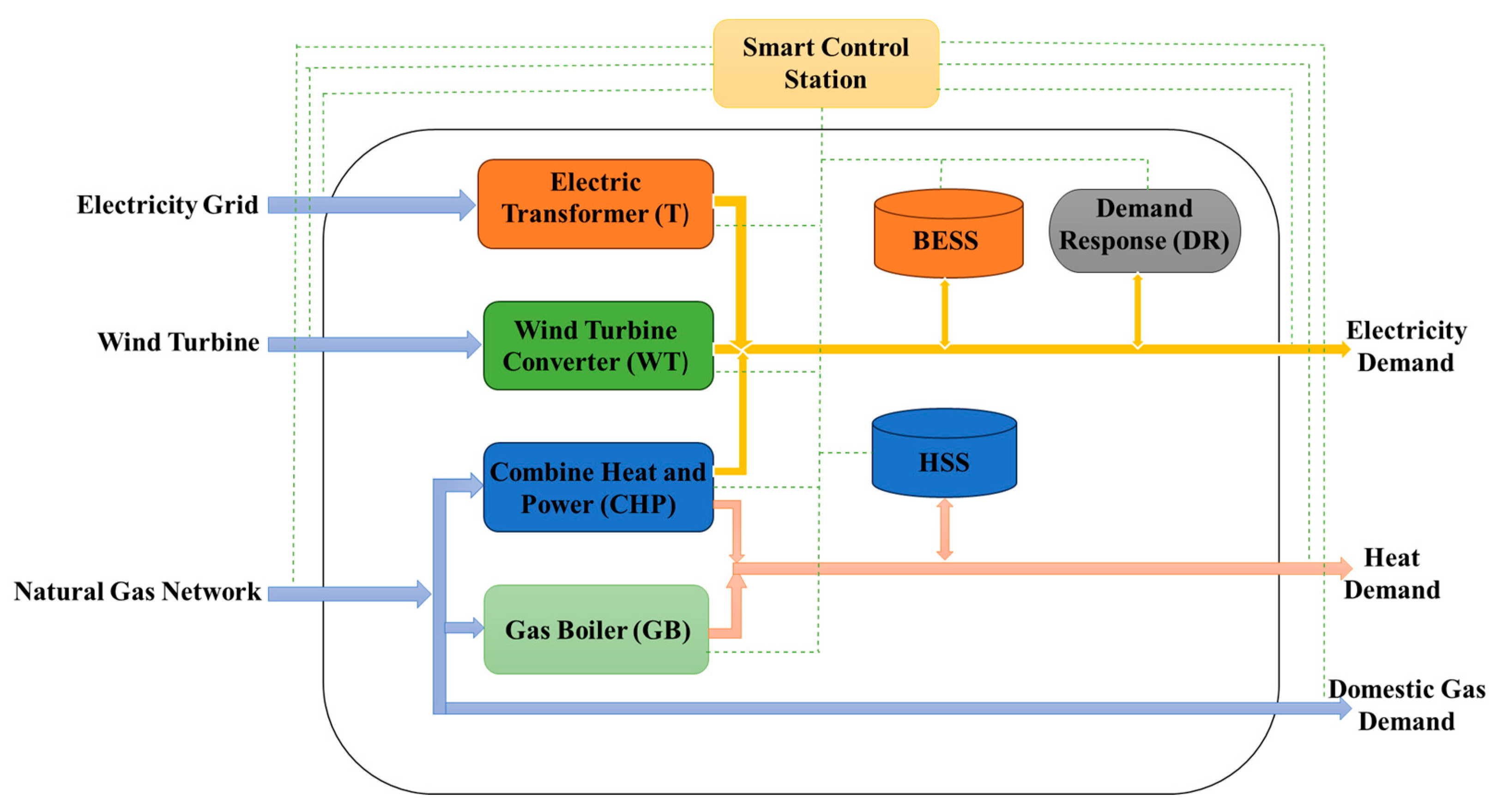

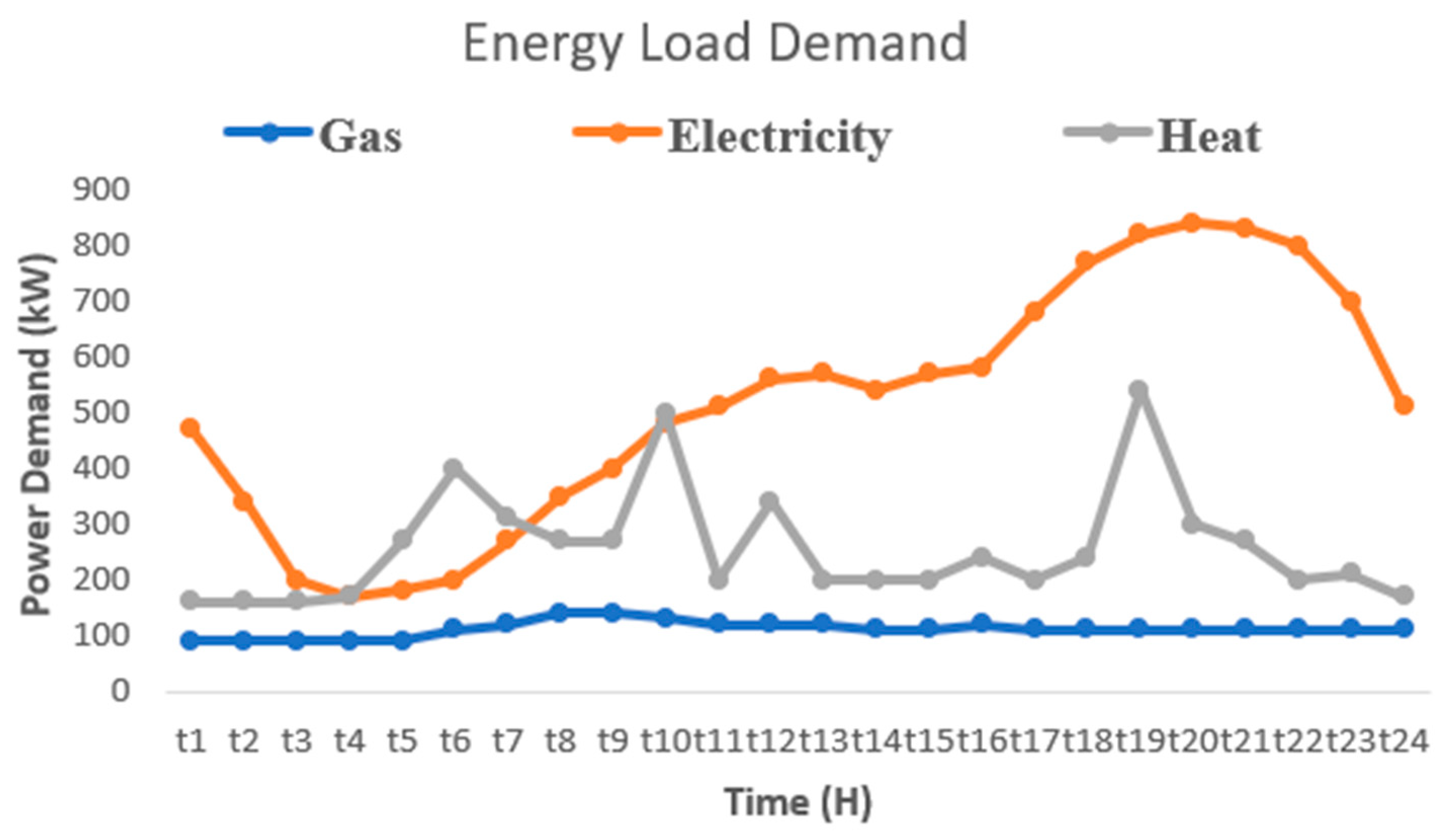



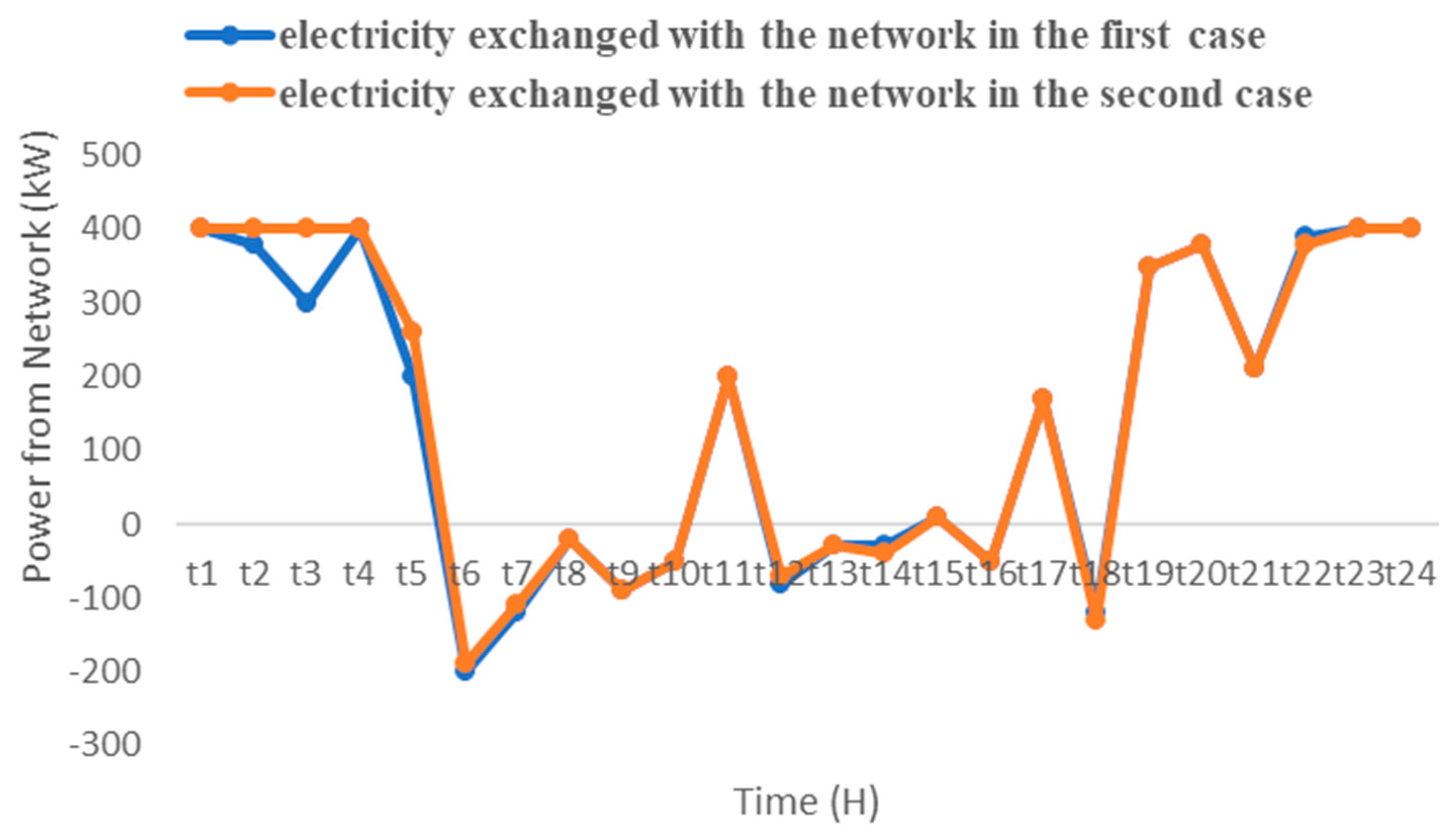
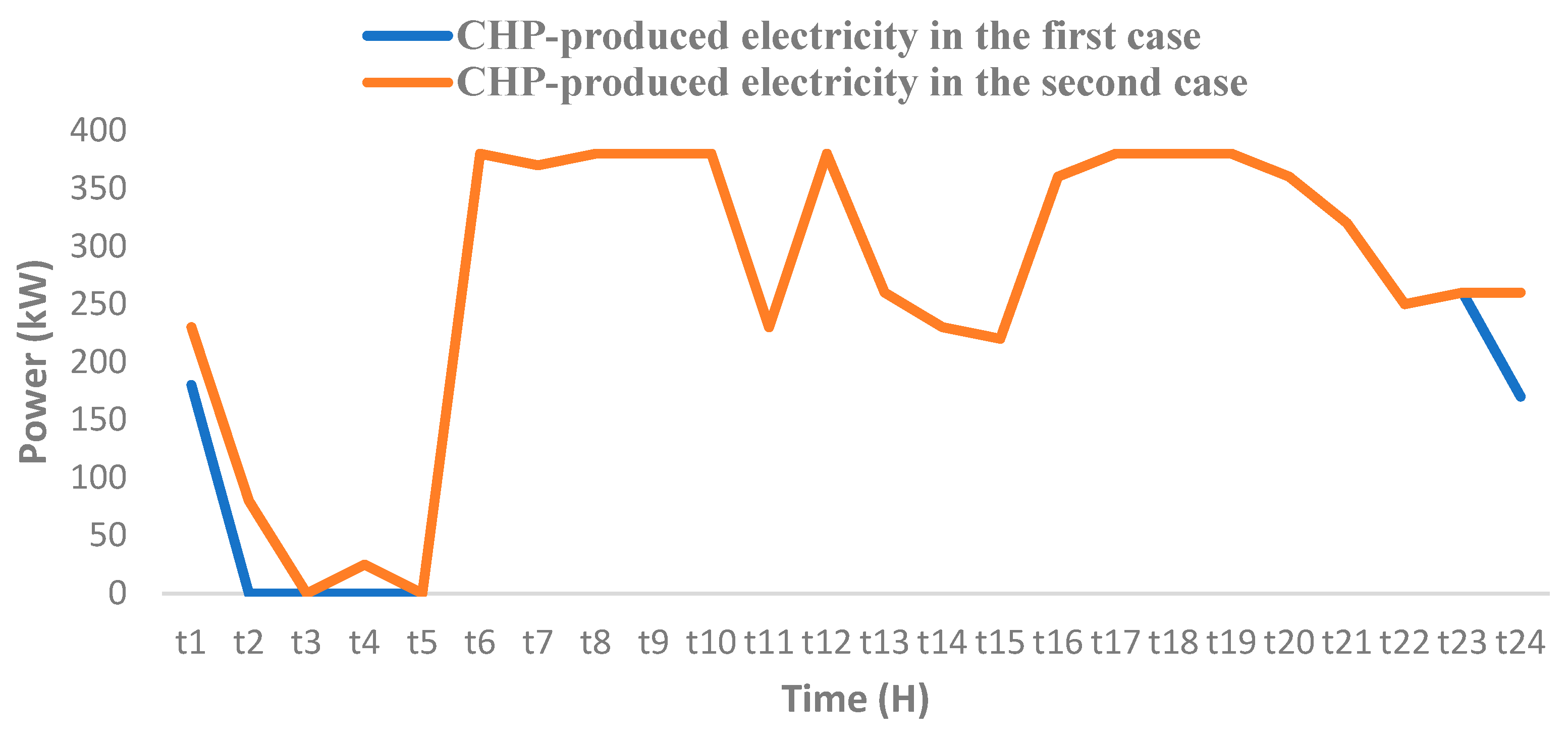
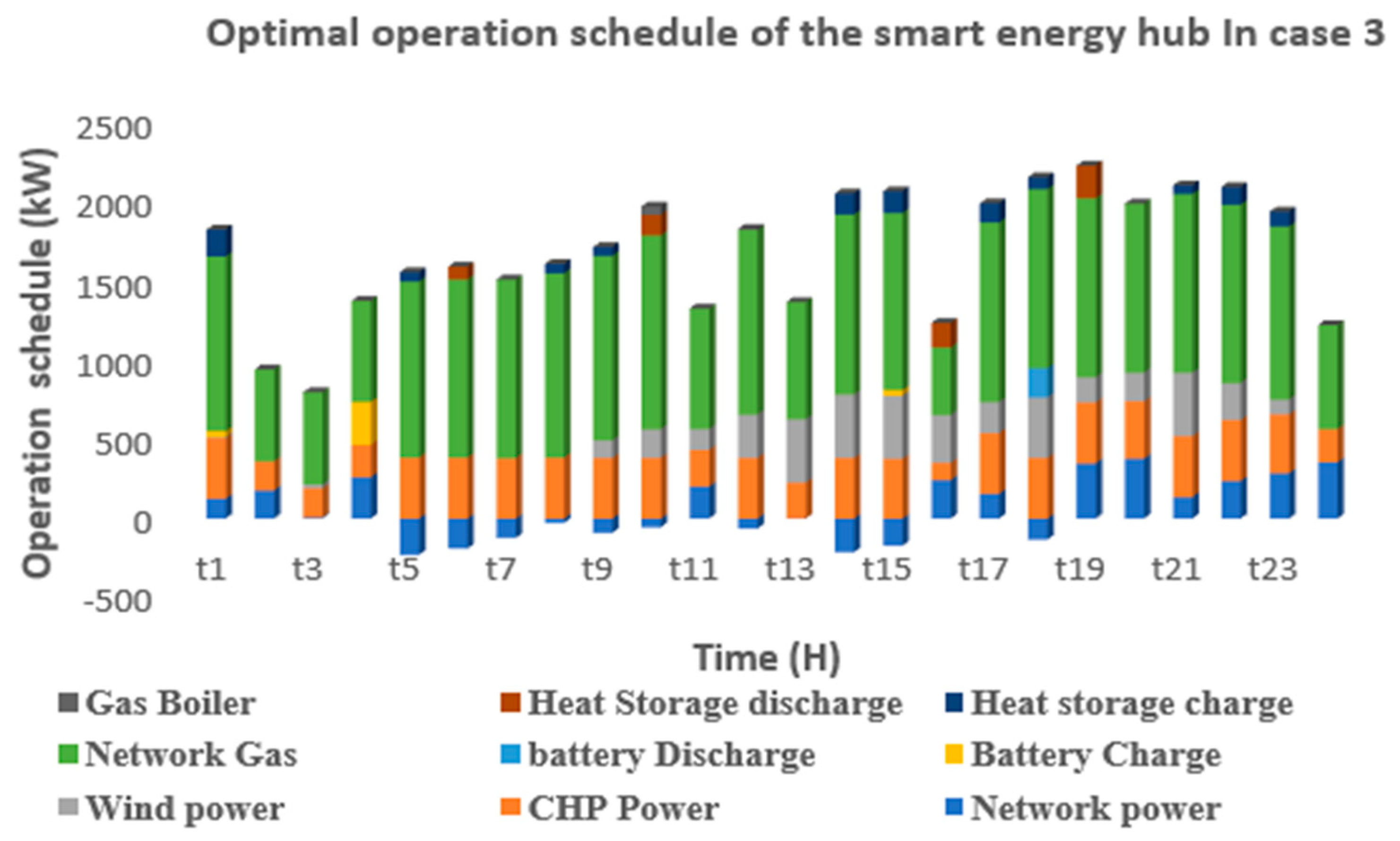
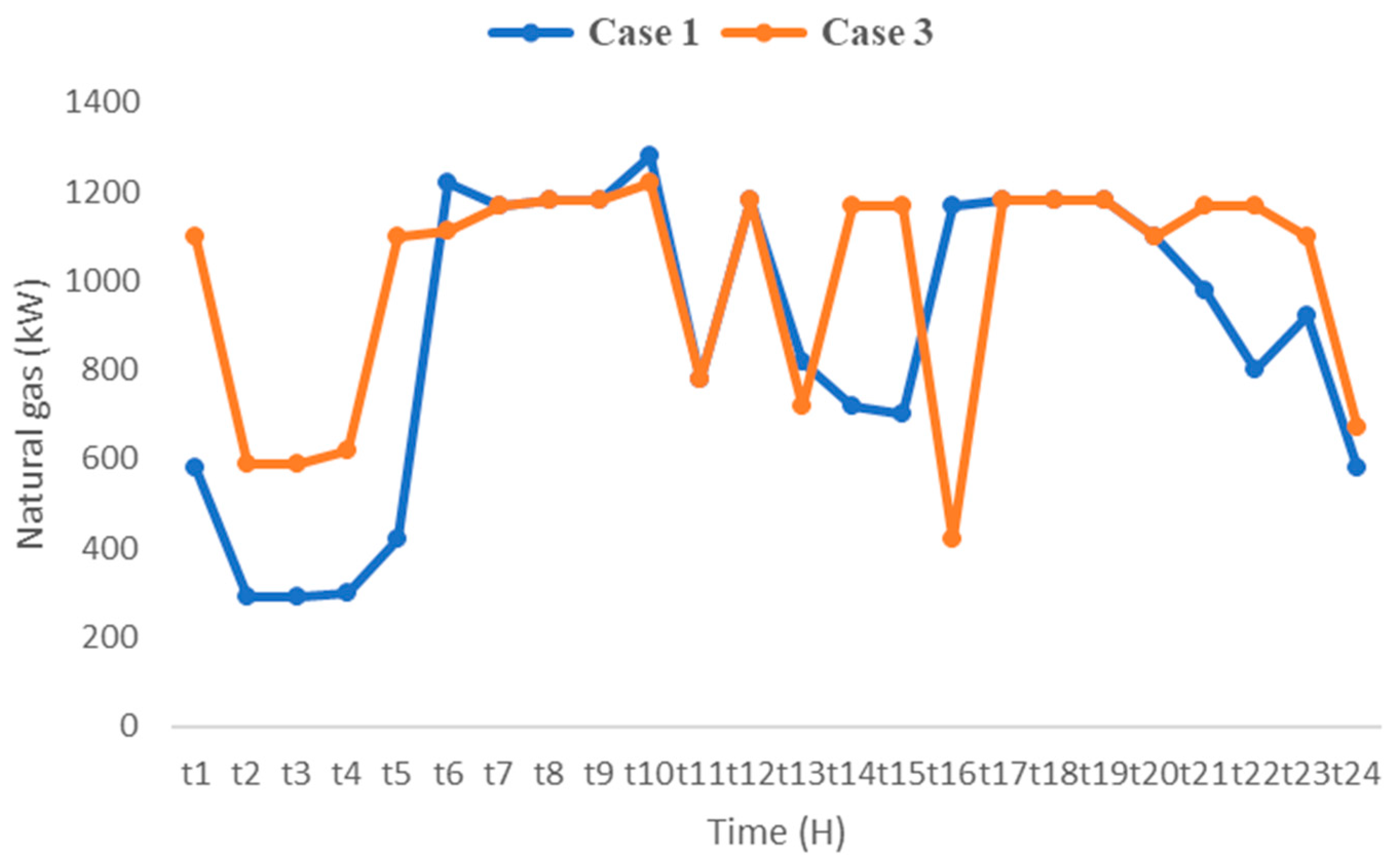
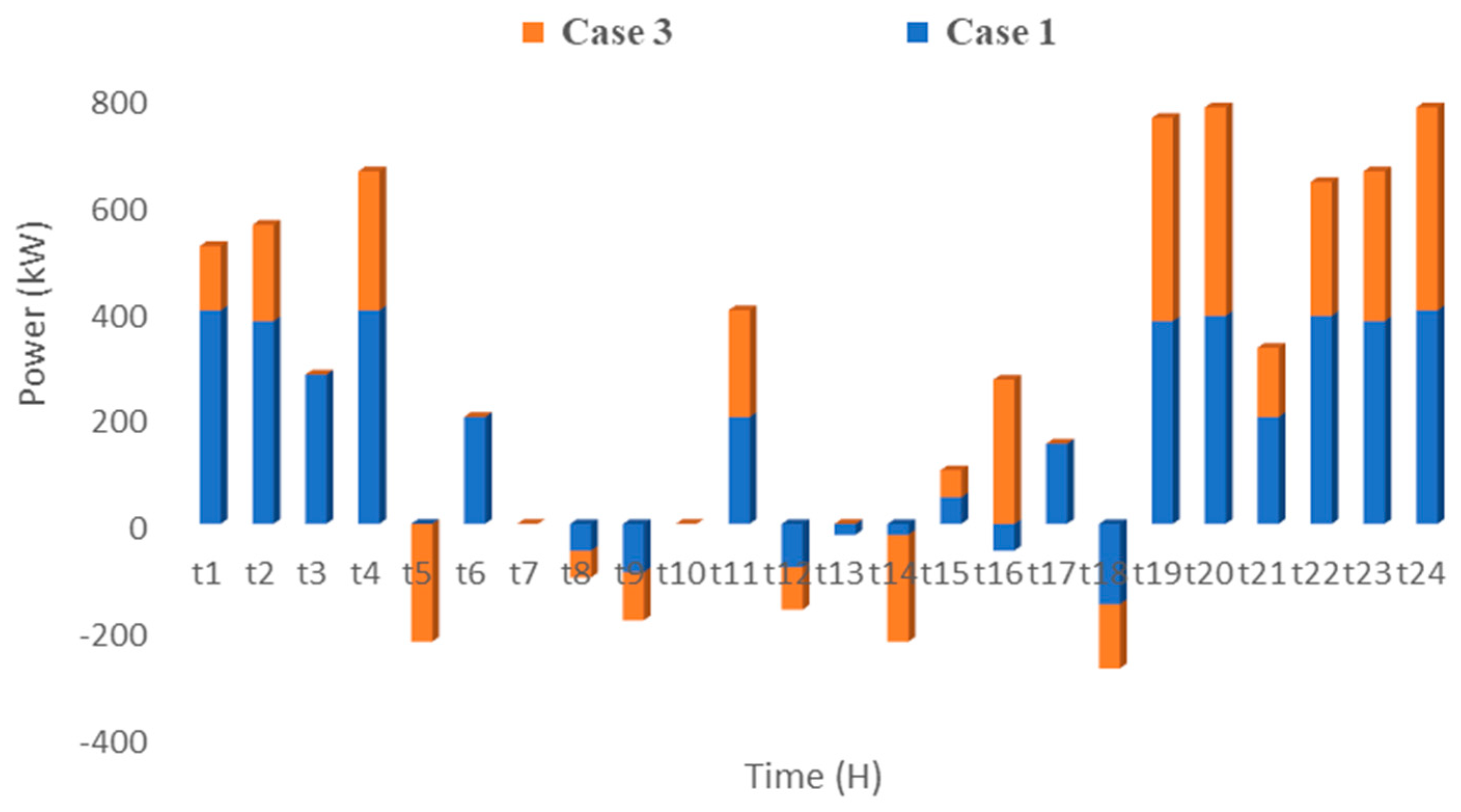
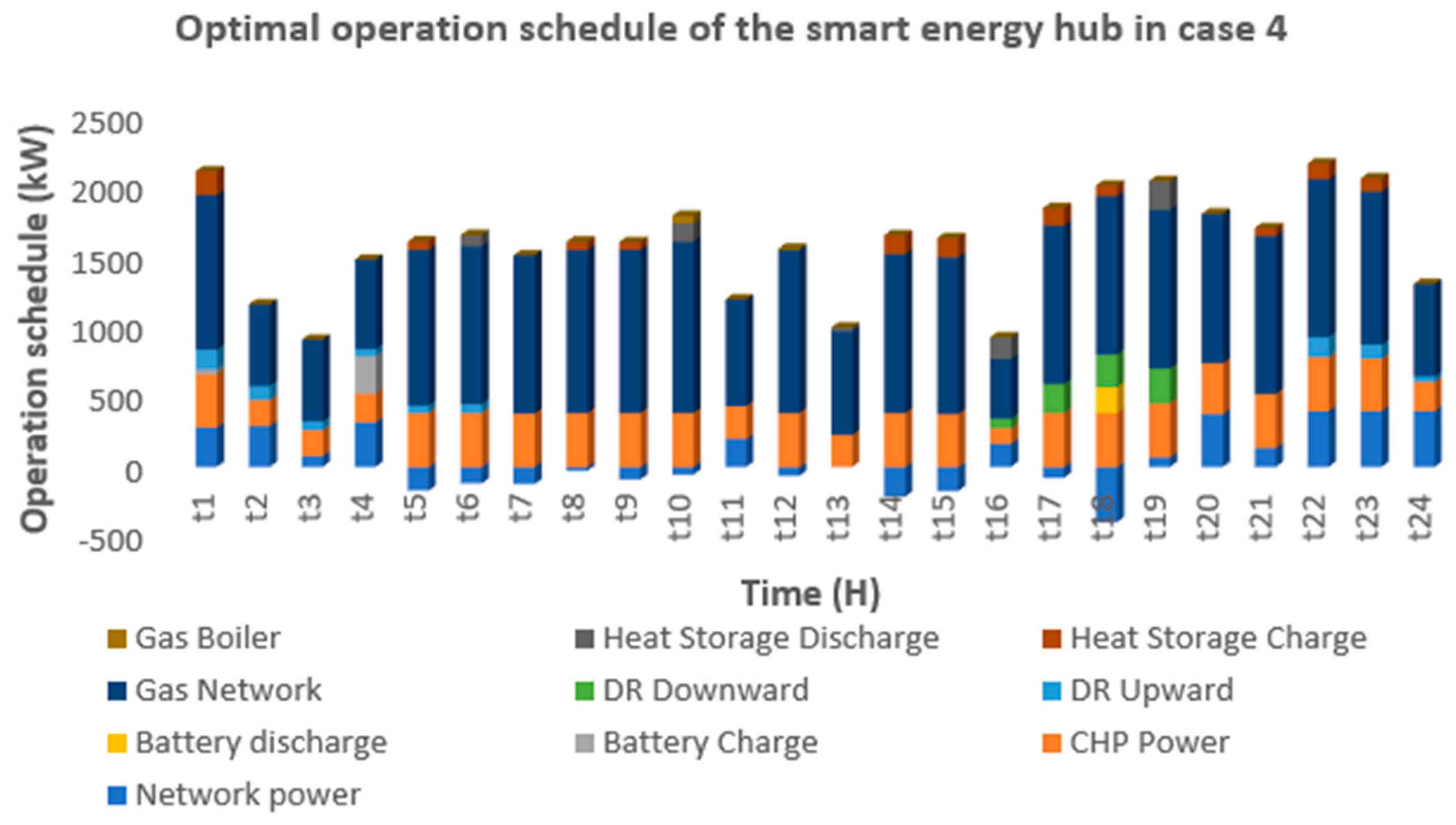



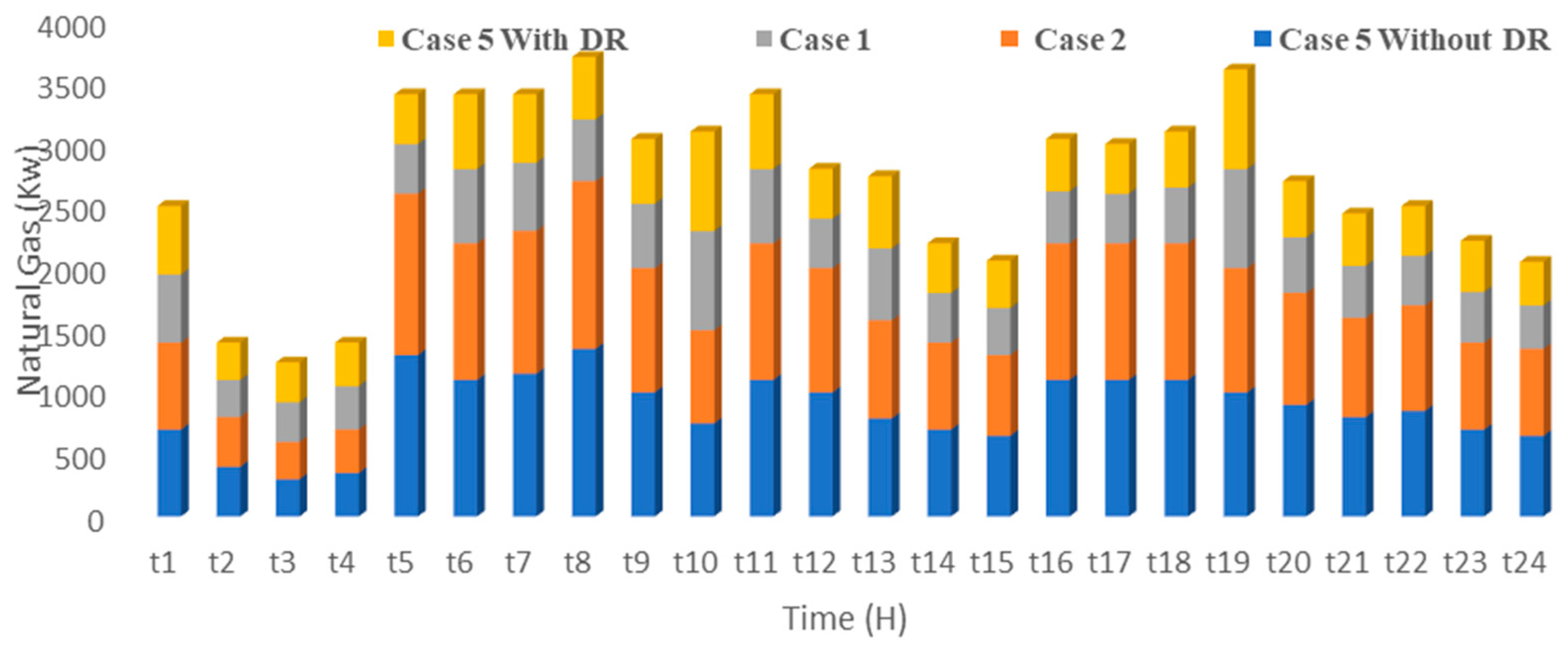
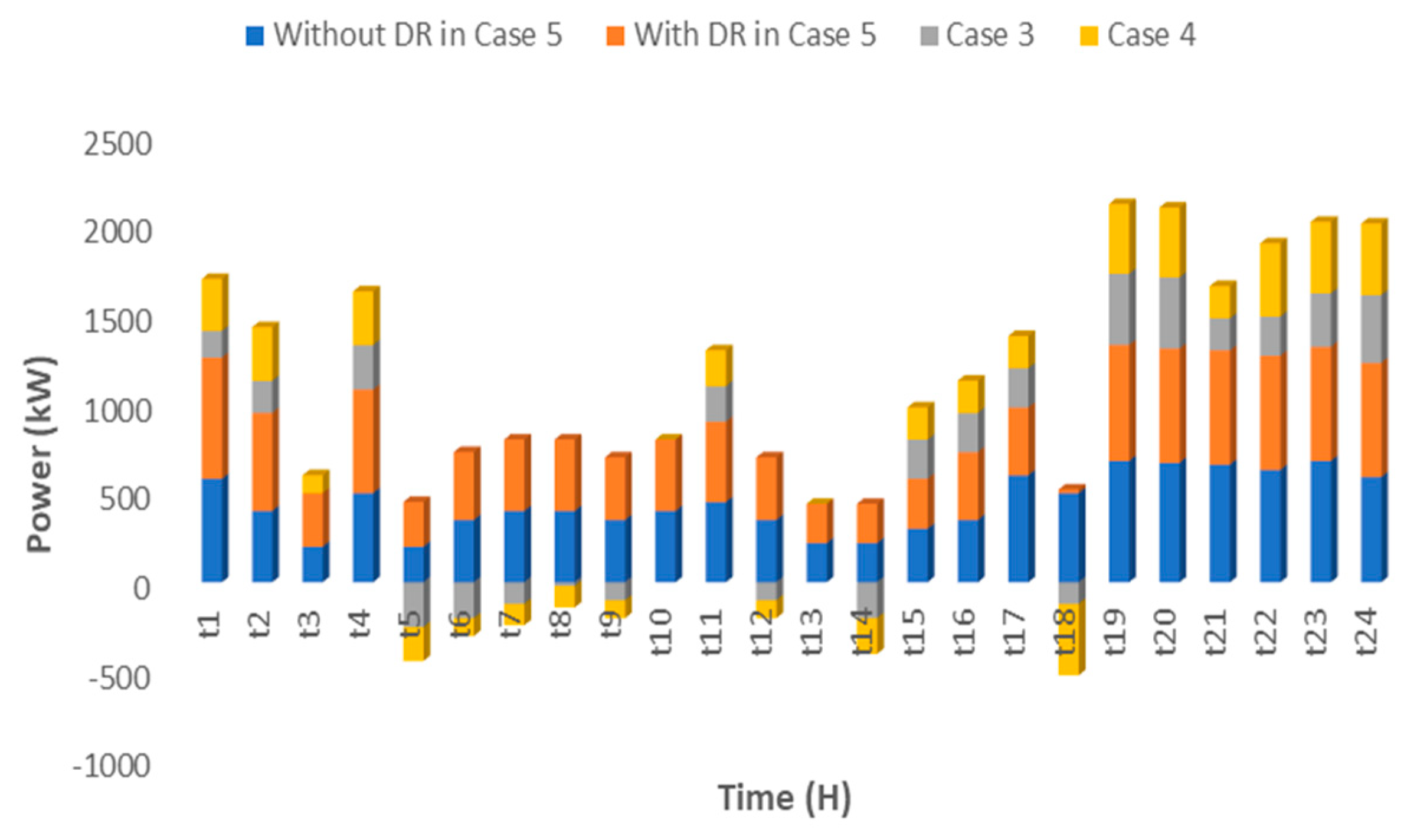
| Scenarios | Total Operation Cost (M/USD) |
|---|---|
| Scenario 1 | 15,576.73 |
| Scenario 2 | 15,270.20 |
| Scenario 3 | 65,094.20 |
| Scenario 4 | 61,395.50 |
Disclaimer/Publisher’s Note: The statements, opinions and data contained in all publications are solely those of the individual author(s) and contributor(s) and not of MDPI and/or the editor(s). MDPI and/or the editor(s) disclaim responsibility for any injury to people or property resulting from any ideas, methods, instructions or products referred to in the content. |
© 2025 by the authors. Licensee MDPI, Basel, Switzerland. This article is an open access article distributed under the terms and conditions of the Creative Commons Attribution (CC BY) license (https://creativecommons.org/licenses/by/4.0/).
Share and Cite
Zubo, R.H.A.; Onen, P.S.; Mujtaba, I.M.; Mokryani, G.; Abd-Alhameed, R. Optimal Scheduling of a Multi-Energy Hub with Integrated Demand Response Programs. Processes 2025, 13, 2879. https://doi.org/10.3390/pr13092879
Zubo RHA, Onen PS, Mujtaba IM, Mokryani G, Abd-Alhameed R. Optimal Scheduling of a Multi-Energy Hub with Integrated Demand Response Programs. Processes. 2025; 13(9):2879. https://doi.org/10.3390/pr13092879
Chicago/Turabian StyleZubo, Rana H. A., Patrick S. Onen, Iqbal M Mujtaba, Geev Mokryani, and Raed Abd-Alhameed. 2025. "Optimal Scheduling of a Multi-Energy Hub with Integrated Demand Response Programs" Processes 13, no. 9: 2879. https://doi.org/10.3390/pr13092879
APA StyleZubo, R. H. A., Onen, P. S., Mujtaba, I. M., Mokryani, G., & Abd-Alhameed, R. (2025). Optimal Scheduling of a Multi-Energy Hub with Integrated Demand Response Programs. Processes, 13(9), 2879. https://doi.org/10.3390/pr13092879











